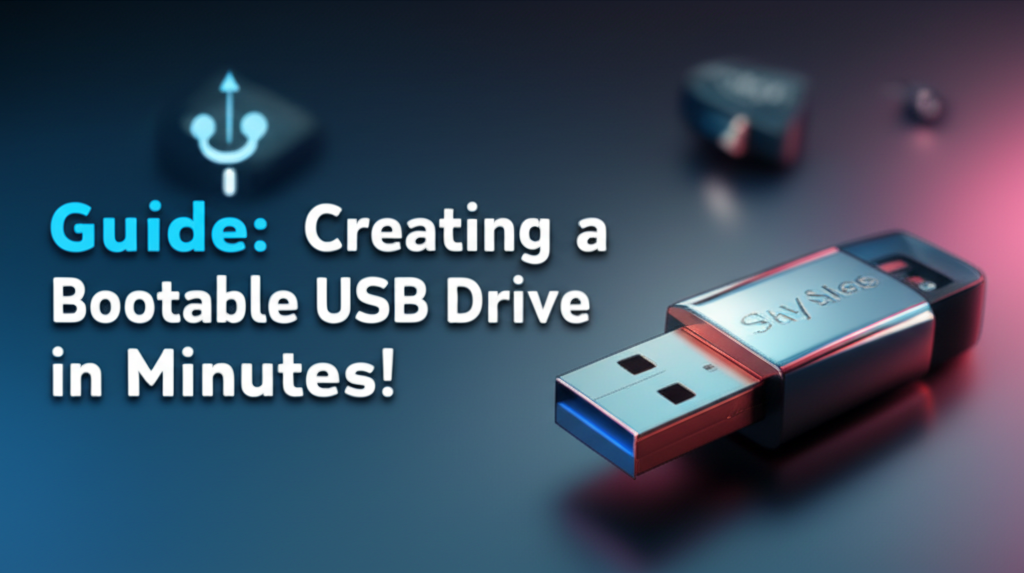Creating a bootable USB drive may seem like a daunting task, especially for those who are new to technology. However, bootable USB drives are essential tools for installing operating systems, running diagnostic tools, or recovering data from a corrupted system. In this guide, we’ll walk you through the process step-by-step, ensuring that you can successfully create a bootable USB drive in just a few minutes.
Why You Might Need a Bootable USB Drive
While many users are familiar with installing software from a CD or DVD, the landscape of operating systems and software installation has shifted towards flash drives. Here are a few scenarios where you might need a bootable USB:
- Operating System Installation: Installing Windows, Linux, or macOS might require you to boot from a USB drive.
- System Recovery: Bootable USB drives can help troubleshoot and repair damaged systems.
- Running Live Environments: You can run a full operating system directly from the USB without installing it on your computer.
Step 1: Gather Your Materials
Before we begin, make sure you have the following:
- A USB Flash Drive (at least 8GB recommended)
- A computer with an internet connection
- The ISO file of the operating system you wish to install
- Access to a tool for creating bootable USB drives (this guide will cover several options)
Common Beginner Mistakes:
- Using the Wrong USB Drive: Double-check that you have the correct USB drive selected to avoid data loss.
- Outdated Software: Ensure that the software you are using to create the USB is up-to-date.
Step 2: Download the ISO File
To create a bootable USB drive, you need an ISO file of the operating system you want to install. Here is how to download it:
-
Windows:
- Go to the Microsoft Windows Download page.
- Select the edition you would like, click “Confirm,” and then choose the language and architecture.
-
Linux:
- Visit the website of the Linux distribution you want (e.g., Ubuntu, Fedora).
- Click on the download button.
Step 3: Choose a Tool to Create a Bootable USB Drive
There are various tools available for creating bootable USB drives. Here are three popular ones:
- Rufus (Windows)
- Etcher (Windows, macOS, Linux)
- UNetbootin (Windows, macOS, Linux)
We will focus on Rufus for this tutorial, as it is user-friendly and widely used.
Download and Install Rufus
- Go to the Rufus official website.
-
Click on the latest version to download it. No installation is necessary; the tool runs directly from the executable file.
Step 4: Create the Bootable USB Drive Using Rufus
-
Open Rufus:
- Double-click the downloaded Rufus executable to launch the application.
-
Insert USB Drive:
- Connect your USB flash drive to the computer. Rufus should automatically detect it.
-
Select Your USB Drive:
- Under "Device," make sure your USB drive is selected.
-
Select the ISO File:
- Click on the "SELECT" button under the "Boot selection" section.
- Navigate to the location of your downloaded ISO file and select it.
-
Partition Scheme:
- For most users, the default “MBR” (Master Boot Record) scheme should suffice. If you’re using UEFI, select “GPT” (GUID Partition Table).
-
File System:
- Choose “FAT32” for compatibility with most systems.
-
Start the Creation Process:
- Click on the “START” button.
- A warning message will inform you that all data on the USB drive will be destroyed. Make sure you have backed up any important data.
-
Wait for Completion:
- Rufus will create the bootable USB drive, which may take a few minutes.
- Finish:
- Once completed, a "READY" status will appear. You can now close Rufus.
Step 5: Boot from the USB Drive
This is the final step where you’ll boot your computer from the USB drive. Here’s how to do it:
-
Restart Your Computer:
- With the USB drive inserted, restart your computer.
-
Access Boot Menu:
- As your computer starts up, repeatedly press the key to access the boot menu. This key varies by manufacturer (usually F12, Esc, F2, or Del).
-
Select USB Drive:
- From the boot options, select your USB drive.
- Follow Installation Instructions:
- If you created a bootable USB for an operating system, follow the on-screen instructions to install it.
Common Mistakes to Avoid:
- Not Changing Boot Order: If your computer doesn’t recognize the USB drive, check if you need to change the boot order in BIOS/UEFI settings.
- Incorrect USB Format: Ensure the USB is formatted correctly during the Rufus setup.
Alternative Methods and Tools
While Rufus is a great choice, there are other methods and tools for creating bootable USB drives:
-
Etcher:
- A simple and straightforward tool available on multiple platforms.
-
UNetbootin:
- A versatile option that works with various Linux distributions.
- Command Line (Windows):
- For advanced users, you can use the ‘diskpart’ command to create a bootable USB manually.
Command Line Steps:
- Open Command Prompt as an administrator.
- Type
diskpartand press Enter. - Use the following commands:
list disk(to list all disks)select disk X(replace X with your USB drive number)cleancreate partition primaryformat fs=fat32 quickactiveexit
Additional Tips:
- Check Compatibility: Make sure your computer supports USB booting.
- Use a Fast USB Drive: The faster the drive, the quicker the installation process.
Final Checklist
Before you conclude that your task is complete, make sure to review this checklist:
- [ ] Did you download the correct ISO file?
- [ ] Is the USB drive formatted properly?
- [ ] Did you select the right drive in Rufus?
- [ ] Was there a warning before starting the process?
- [ ] Did you boot from the USB drive correctly?
- [ ] Were the installation steps followed successfully?
Creating a bootable USB drive can be done in a matter of minutes, and following these steps simplifies the process considerably. Armed with this guide, you’re now well-prepared to create your own bootable USB drives, whether for operating system installations or recovery purposes. Happy computing!

